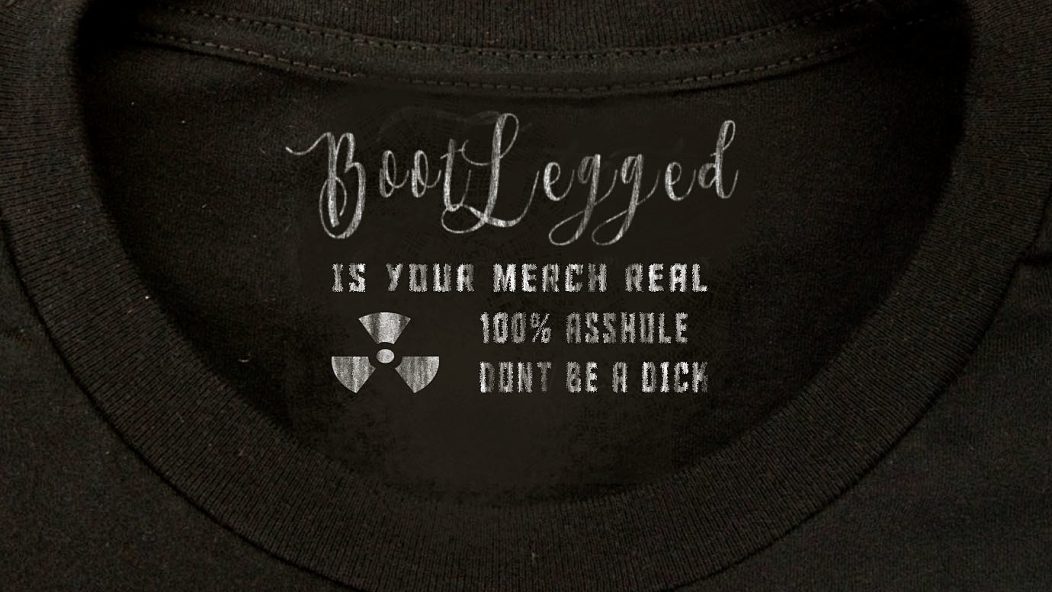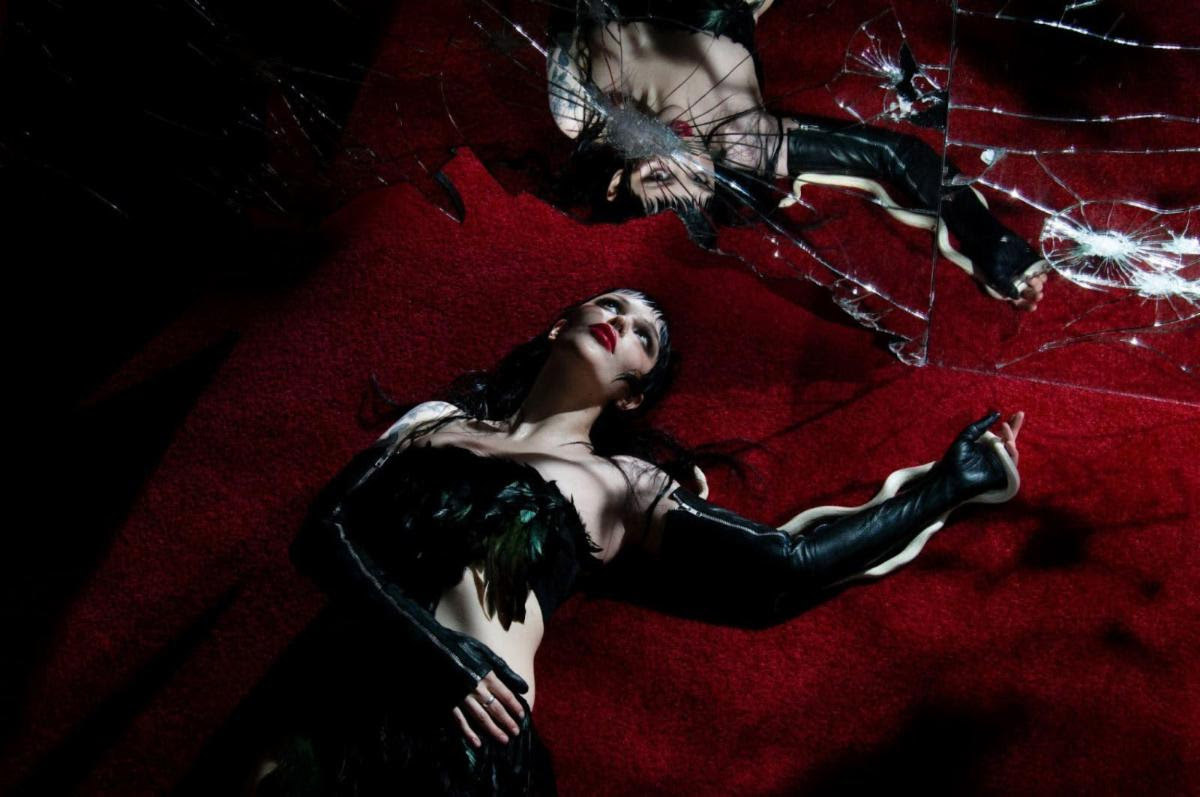
Bootlegged: Is Your Merch Real?
…
“That’s our bloodline, our life support, making and selling merchandise on the road. You make some show money, but that goes back into your production, your bus, your roadies. Merch keeps us alive; that’s how we make a living. When someone is selling bootleg merch, they’re taking that away.”
Obituary bassist Terry Butler confirms what most people with even a loose understanding of today’s music industry know on some level. Now that the days booming record sales are a relic, a band’s merchandise is a crucial element for artists to make a living. When people sell and buy merchandise that’s not made by, for, or with a band, they’re taking money right out that band’s wallet.
…
Musicians and the people that work with them know that the culprit is the bootleg seller, and most fans are just innocently seeking something that reps the band they love. But the band’s earnings take a hit all the same. Robin Mazen has experienced the presence and effects of bootleg merch as both a musician and a merchandise manager. Bassist for bands like Derkéta and Gruesome, Mazen has also handled merch for the likes of Cannibal Corpse and Dark Tranquility and was on the Decibel tour with Obituary when we spoke.
“I get fans’ perspective,” she says. “They want something with the band’s name on it and they don’t have a lot of money and a lot of people don’t know how wrong it is to do. They just want to promote the band…[but] you’re promoting people that are basically stealing from the band’s pocket. It keeps the bands from being able to make money on tour, depending on their level.”
On top of assaulting a band’s bottom line, bootleg merchandise is difficult and sometimes even impossible to fight.
“The market is fluid and bands are constantly trying to address the bootleg problem as the bootleggers become better at evading detection,” says entertainment lawyer Scott Burroughs. “Depending on the artist, there can be more people outside the venue selling bootleg stuff than authorized sellers offering the real deal.”
To make matters worse, enter: the internet. Bootleg sellers outside of shows are nothing new, but websites like Amazon, which is just the massive tip of the e-com iceberg, are making it exponentially easier to sell unauthorized merchandise, and exponentially more difficult for bands to track all of that merch down.
“It’s hard with some of the sites that might be in Mexico, or China, or Europe,” Butler says. “You investigate anything you find as best you can. You have your lawyer send them an email, and that’s about all you can do. Especially on eBay, there’s tons of illegal stuff. Our only official stuff is what we’re selling when we’re on tour, or what’s on our merch store on our website. Everything else out there is illegal, and it’s a constant battle.”
From the infinite abyss of the internet to the venues on tour, monitoring merchandise has become a constant part of the job description. Write, record, coordinate dates, handle press, work on your own legitimate T-shirt designs and licensing, try to catch the illegitimate stuff before the seller makes too much money off of you — all in a day’s work.
“In L.A., we’ve had police or security that chase the [bootleg sellers] off the property, but if something happens to the bootlegger, then the club is responsible,” Mazen says.” “We’ve also hired and paid security at different venues to get these people off the premises. But the next time you come around, you just see the same people back again.”
If a band does manage to nab an unauthorized seller, they can bring copyright and trademark claims in court, Burroughs says.
“If the artwork on the merch is registered (which we highly recommend), the band can recover statutory damages of up to $150,000.00 plus its costs and attorney’s’ fees. This is sufficient in most cases, but it is still very difficult to go after the one-off bootlegger that is selling a bag of knock-off shirts in the parking lot because he or she may be difficult to catch and haul into court.”
Given how hard it is to track down bootleg sellers, and how much harder it is to actually succeed at stopping them, trying to get fans to only buy authorized items is probably the best solution. The easiest way to know a t-shirt is legitimate is to buy directly from the band at a show or on their website, but wading out into the world of retail, especially online, can take fans into murky territory.
“Spotting bootleg merch online is like spotting a spam e-mail, you have to have an eye for what is official and what is not,” Vince Edwards of Metal Blade Records notes.
There’s merch sold at shows and merch sold online, and then there’s another seemingly ever-expanding curveball: the band name-splashed fashion items from mega-retailers like H&M, Forever 21, and Urban Outfitters. The question of “legitimacy” here is really more about fan cred. Stores this big can’t get away with ripping bands off, and when they try to, they tend to get sued, or at least forced to pull the designs.
Mazen and Louis Benavides, another merchandise manager who’s currently on tour with the XX, explain that the shirts hanging anywhere from Target to Wal-Mart get there through licensing agreements made with the band, and the band gets an advance and/or a percentage of the sales. So, those items are legally above the board, no matter how offensive it might seem to some fans.
Then there’s another burgeoning market outside of bands’ merch stands and websites. Lines like Speed Clothes offer an alternative to the standard lineup of t-shirts, and designers like Speed’s Tanza lead the way to diversifying metal merchandise to catch up to the melting pot of metal fans. This trend does create a whole new avenue for bootleg items. If anyone can create a fake band t-shirt, anyone can create a fake band swimsuit. There’s no failsafe trick to avoiding unauthorized merch here other than employing some common sense. If it’s on a personal Etsy page and it’s cheap, it’s probably bootleg. Stick to professional operations like Speed, who build business on band partnerships.
“Once I get [the band’s contact info], I have to explain what my product is all about and why they should totally do it,” Tanza explains. “Many times, it’s the band contacting me to do their merch, too. It was like that for Satyricon and Dark Funeral, for example.”
The process is collaborative for brands like Speed, the designers keeping the band in the loop or even letting them guide the way so they’re happy with the finished product. Then the payout for the band depends on the particular agreement and the particular brand that they are working with. For Speed, “a royalty is paid for each product, which is paid up-front, before mass production, instead of monthly or quarterly like the majority of labels do.”
…

Photo courtesy of the Speed Clothes Facebook.
…
Since most metal fans presumably aren’t picking up their tees at H&M, that leaves these authorized, more unique merchandise makers, and the time-honored t-shirts sold directly by the bands. Even then, it helps to know a few things to keep one’s closet bootleg merch-free. Benavides had a lot of tips ranging from minute to overarching for making the distinction.
“One easy way to spot bootleg merch outside of a metal show (aside from the fact that they’re selling cheap merch outside, which should be an obvious sign) is if the size tag is cut in the middle. These are defective blanks and you can get them really cheap from shirt vendors. They may not have much wrong with them — stitching errors, length and width are off, etc. — so the bootleggers typically use those because they cost nothing. Another sign is if you see all the bands [of the tour or festival] on one shirt; very rarely does a band sign off on having their names on a shirt to split the profits.”
In addition to the cut size tags, certain t-shirt manufacturers can also be a giveaway, so pay attention to those tags, Benavides says. Brands like Winterland, Brockum, and Signatures went out of business a while ago, so when it comes to a vintage band tee on eBay, those companies could be signs that the item is legit.
“Screen Stars is a company that supplied blanks for so many tours, and they have been out of business for like 20-plus years, so if you get a shirt with that label, it’s more than likely the real deal.”
When asked if they think bootleg merch is a problem that will continue on, Mazen, Burroughs, and Benavides all point to issues like the lack of recourse and rise of e-commerce as reasons that yes, they do think the problem is here to stay. Benavides’s observation also serves as a cold, hard rundown of what bands are investing into their merchandise only to be ripped off by bootleggers.
“My favorite thing is when someone comes to the merch table and says something like ‘I could make that shirt at home for $5’ or something like that. But they never factor in the impracticality of their statement. They probably could make that shirt at home for $5 if they worked at a print shop with the surplus of blanks. Here is how shirts break down with the profits to be distributed.
Let’s take a two-side, four-color $25 shirt. The cost per screen is $30. This one will need two screens. So automatically, you have to sell three shirts to start making any profit. The cost of the shirt is $2-$4 depending on what the blank is. The cost of printing is $2-$6 depending on what you want. So let’s say you have four shirts to sell totaling $100 of potential profit. You’re down to $40. Minus the let’s say $6 print job. You’re down to $34. Oh, there’s tax and a venue fee? 8% tax and a 20% split. You pay $8 in tax and $18 in venue fee. You’re down to $18 in potential profits. Quite the jump. This also doesn’t include shipping, paying the road guy, etc.”
Bootleg merchandise hurts bands and, plain and simple, is fraud. Inauthentic. Not true fan support. It’s a headache for artists from losing profits to continually trying to find ways to stop the spread of unauthorized items. For just a small jump in price, fans can actually support the band they want to rock the name of, and they can have something real, directly from that band. The moral of the story is to buy directly from the band, either at their merch table or on their website, every time. It completely crosses off the possibility of coming into contact with bootleg merch. And with how impossible it is to stop the bootleggers, themselves, fans shopping responsibly is the only way this problem could ever begin to shrink.
…











